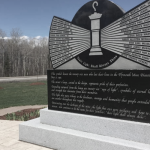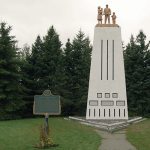It’s not listed among the top tourist destinations in Ottawa, but if you are visiting the National Capital Region this summer (as many Canadians do), you may wish to pay your respects to the nine workers who went to work that day and never got to go home, and the other 55 whose lives were forever changed.
[[{“fid”:”1457″,”view_mode”:”default”,”fields”:{“format”:”default”,”field_file_image_alt_text[und][0][value]”:”Photo of men searching through the debris of the Heron Bridge collapse.”,”field_file_image_title_text[und][0][value]”:”CITY OF OTTAWA ARCHIVES, CA02527″},”type”:”media”,”field_deltas”:{“1”:{“format”:”default”,”field_file_image_alt_text[und][0][value]”:”Photo of men searching through the debris of the Heron Bridge collapse.”,”field_file_image_title_text[und][0][value]”:”CITY OF OTTAWA ARCHIVES, CA02527″}},”link_text”:null,”attributes”:{“alt”:”Photo of men searching through the debris of the Heron Bridge collapse.”,”title”:”CITY OF OTTAWA ARCHIVES, CA02527″,”style”:”height: 375px; width: 500px; margin-left: 12px; margin-right: 12px; border-width: 1px; border-style: solid;”,”class”:”media-element file-default”,”data-delta”:”1″}}]]
An official inquest into the disaster laid blame on the engineers, the use of green lumber and the lack of diagonal bracing on the wooden support forms, which caused them to collapse as concrete was being poured to form the bridge deck.
The consequences for those responsible – the Association of Professional Engineers of Ontario suspended two of its members, reprimanded a third, and the construction company, O.J. Gaffney Limited of Stratford, Ontario, was fined $5,000 (the maximum penalty under the Construction Safety Act).
Ontario’s construction safety standards were rewritten following this incident.
In 1987, the Canadian Labour Congress placed its National Monument to Workers Killed and Injured Each Year at Work in Ottawa’s Vincent Massey Park, within sight of the bridge. It is here that the Canadian Labour Congress, the Ottawa & District Labour Council, and local unions hold their ceremony each year on April 28 to mark the National Day of Mourning for workers killed or injured on the job.
Occupational “accidents” and work-related diseases kill more than 2.3 million workers around the world each year. According to the Canadian Centre for Occupational Health and Safety:
“The most recent statistics from the Association of Workers’ Compensation Boards of Canada (AWCBC) tell us that in 2016, 904 workplace deaths were recorded in Canada. Among those dead were 5 young workers aged fifteen to nineteen years; and another 20 workers aged twenty to twenty-four years.
Add to these fatalities the 240,682 claims accepted for lost time due to a work-related injury or disease, including 7,562 from young workers aged fifteen to nineteen, and the fact that these statistics only include what is reported and accepted by the compensation boards, and it is safe to say that the total number of workers impacted is even higher.
What these numbers don’t show is just how many people are directly affected by these workplace tragedies. Each workers death impacts the loved ones, families, friends and coworkers they leave behind, changing all of their lives forever.”


